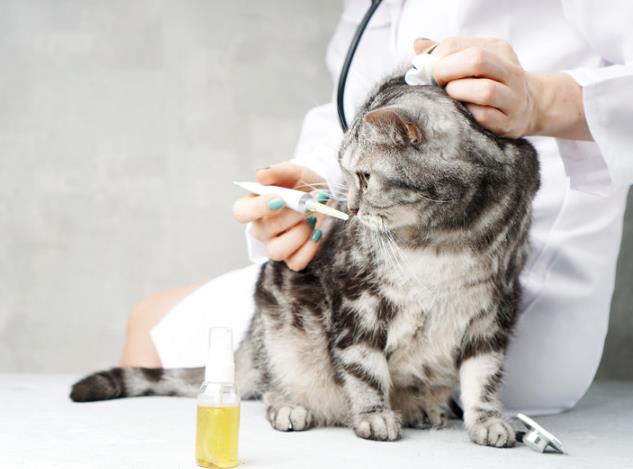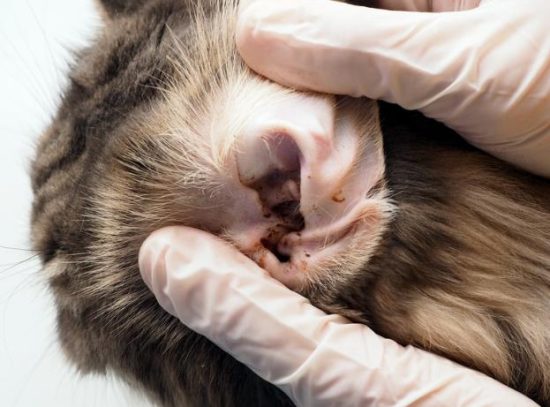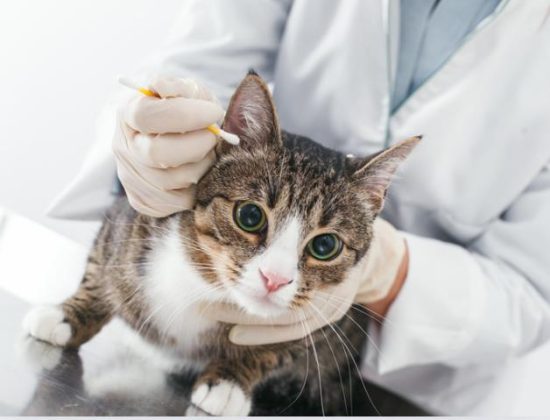How to Check for Ear Mites in Cats: A Helpful Guide
Learn how to easily check for ear mites in your feline friend by observing common symptoms and performing simple at-home inspections with this helpful guide.

Did you know that half of all cats get ear mites at some point? These small bugs can make your cat very itchy and irritated. It’s important for cat owners to spot and deal with ear mites.
Your cat might bring along some unwelcomed guests. Whether it’s ticks, fleas, or ear mites, these pests cause a lot of trouble. Learn how to check for ear mites in cats. Also, know how to treat them.
Key Takeaways
- Ear mites are a common and highly contagious parasite that can infect cats and cause significant discomfort.
- Signs of ear mites include ear scratching, head shaking, redness, and a dark, crumbly substance in the ears.
- Prompt veterinary diagnosis and treatment are crucial to eliminate an ear mite infestation and prevent complications.
- Regular grooming, cleaning, and use of preventative medications can help keep your cat ear mite-free.
- Avoid using home remedies, as they are not effective at killing ear mite eggs and can lead to recurring infestations.
Introduction to Ear Mites in Cats

Ear mites are tiny creatures that like to live on cats, dogs, and other animals. They survive by feeding off the skin of these animals. These annoying ear mites usually make their home in the ear canal. But they can also be found on the skin near the ears or elsewhere on the body.
This causes a lot of itchiness and discomfort for cats. It’s really important to understand what feline ear mites are all about. Knowing their habits can help you fight and prevent these parasitic infestations. By learning about ear mites in cats, you can do a lot to keep your pet’s ear health in good shape. This also helps their general health and happiness.
Ear mites have a fast life cycle, which helps them spread quickly. A female can lay up to 50 eggs. These eggs then hatch within a week. The young mites become adults in just 2-3 weeks. This fast cycle means the mite population can grow really fast. And all this happens inside the animal’s ear. Knowing how they reproduce is key to stopping their spread.
Signs and Symptoms of Ear Mites in Cats
Spotting ear mites in cats is hard because they’re too small to see. Still, some signs can show your cat has ear mites.
Physical Appearance
Sometimes, you might see tiny white spots on your cat’s fur. But you’ll often notice redness, bumps, or a rash near the ears. Your cat may have a dry, crumbly substance in the ears and a bad smell around them. The physical signs of ear mites are often the first indicators that a cat is infested. The appearance of a cat’s ears and the surrounding area can change significantly when ear mites are present.
Behavioral Changes
Cats with ear mites act differently. They might shake or tilt their heads a lot, and they could also scratch their ears too much, leading to more problems like sores or hair loss. In addition to physical symptoms, ear mites can also cause noticeable behavioral changes in cats. These changes are primarily driven by the discomfort and irritation caused by the mites.
Ear Discharge and Odor

Ear mites cause significant changes in the ear environment, leading to noticeable discharge and odor. These signs are often what prompt cat owners to seek veterinary assistance. One of the hallmark signs of ear mites is the presence of dark, crumbly discharge in the ear canal. This discharge is often described as resembling coffee grounds and consists of ear wax, blood, and the mites themselves. It can vary in color from dark brown to black and is usually quite distinctive.
Don’t ignore your cat if it shows these signs. Early treatment can ease its troubles and prevent further problems.
How Do Cats Get Ear Mites?
Ear mites are a common and troublesome parasite for cats, causing significant discomfort and potentially leading to more severe health issues if left untreated. Understanding how cats get ear mites can help in preventing infestations and ensuring that our feline friends stay healthy. The primary modes of transmission are direct contact with infected animals, exposure to contaminated environments, and mother-to-kitten transmission. The main ways they spread are:
Direct Contact with Infected Animals
Direct contact with other animals is the most common way cats acquire ear mites. This form of transmission is particularly prevalent in environments where cats interact closely with one another. Cats are social animals that often engage in grooming, playing, and sleeping together. During these activities, ear mites can easily transfer from an infected cat to a healthy one. Grooming is a particularly effective means of transmission, as cats frequently clean each other’s ears, providing an ideal opportunity for mites to spread.
Exposure to Contaminated Environments
Cats can also contract ear mites from environments where the parasites are present. Ear mites can survive for a short period outside of their host, making contaminated spaces a potential risk for cats. Shared items such as bedding, toys, and grooming tools can harbor ear mites and facilitate their spread from one cat to another. If an infected cat uses these items, the mites can transfer to a healthy cat that subsequently comes into contact with the same items. Regular cleaning and disinfecting of shared items can help mitigate this risk.
Mother-to-Kitten Transmission

Mother-to-kitten transmission is a critical way ear mites spread, particularly in young cats. This transmission mode occurs when an infected mother cat passes the mites to her kittens, either during birth or through close contact in the early weeks of life. If a mother cat has an ear mite infestation, there is a high likelihood that her kittens will also become infested. During birth, kittens are in close contact with their mother, and the mites can easily transfer from the mother’s ears to the kittens’ ears.
If cats roam outdoors or live with other pets, they may face more risks. To lower the chance of your cat getting ear mites, try to keep them clean. Use preventive measures and avoid contact with possibly infected animals.
How to Check for Ear Mites in Cats?
Finding ear mites can be tricky without a pro. You might see some signs but not be sure. The surest way to know if your cat has ear mites is through a veterinarian. A vet can look in your cat’s ears. They might even take a sample to look at under a microscope. This is how they can confirm if ear mites are present.
| Step | Description |
|---|---|
| 1. Observe Behavior | Look for signs like too much scratching, shaking their head, or being agitated near their ears. |
| 2. Inspect the Ears | Check your cat’s ears for redness, a dark, crumbly material, or any unusual discharge. These could mean ear mites. |
| 3. Consult a Veterinarian | Make an appointment with your vet if you think your cat might have ear mites. They can diagnose and suggest a treatment. |
Seeking Professional Diagnosis
If you think your cat has ear mites, the first thing to do is to call a vet. The vet will carefully check your cat’s ears. They do this to look for signs of ear mite infestation. If ear mites are suspected, a sample of the ear wax may be taken with a swab. This ear wax sample is then looked at under a microscope. Finding the mites under the microscope is how they confirm the issue. It’s the best way to diagnose ear mite infection in cats. The vet might do more tests too, like an overall health check. This helps rule out other problems.
Note that most pet insurances cover tests and treatments for ear mites. Always make sure with your provider. A professional diagnosis from a vet is key. Your cat will get the right care and treatment this way.
Treatment Options for Ear Mites in Cats
If your vet says your cat has ear mites, they’ll probably give you a medicine to use. This could be something like selamectin or moxidectin. These drugs come as a liquid to put in the ears or as a pill. Your vet will also clean your cat’s ears and give them the first dose in the office. They might say to come back in a week or two. This is to check if the mites are all gone and if any infections are better.
Topical Medications

Topical medications are often the first line of treatment for ear mites in cats. These medications are applied directly to the cat’s ears or skin and are designed to kill the mites on contact.Veterinarians commonly prescribe medicated ear drops to treat ear mites. These drops typically contain acaricides, substances specifically designed to kill mites. Ingredients such as ivermectin, selamectin, or milbemycin oxime are effective against ear mites. The treatment regimen usually involves administering the drops once or twice daily for a specified period, often around one to three weeks, depending on the severity of the infestation.
Oral Medications
Oral medications can be an effective part of the treatment regimen for ear mites, particularly in cases where topical treatments are insufficient or if the cat is difficult to medicate topically. Ivermectin is a commonly used oral medication for treating ear mites. It works by paralyzing and killing the mites. This medication is usually administered as a single dose or over several days, depending on the veterinarian’s recommendation. Ivermectin is generally effective and well-tolerated, but it is important to follow the prescribed dosage to avoid potential side effects.
Environmental Cleaning and Disinfection
Treating the cat alone is insufficient to ensure complete ear mite eradication. Environmental cleaning and disinfection are crucial to prevent reinfestation. Mites can survive in the environment for a short period, so thoroughly cleaning the cat’s bedding, toys, and any fabric surfaces the cat frequents is necessary. Washing these items in hot water and using pet-safe disinfectants can help eliminate mites and their eggs.
Preventing Ear Mite Infestations in Cats
The top way to avoid ear mites in cats is through regular check-ups and cleanings. Grooming and vet health checks are key. Your vet may suggest using certain products to prevent mites. Also, clean your cat’s favorite spots often to lower the risk of an ear mite infestation.Keeping your cat clean is crucial to avoid ear mites. Make sure they are brushed and checked often.
Working with your vet for a proper ear cleaning plan is important. It stops ear wax and dirt from building up, which attracts ear mites. Your vet might advise using certain drugs to stop ear mites in cats. These can be cream or pill treatments that make your cat’s ears a bad place for mites. Being careful with these prevention steps is a great way to protect your cat’s ears. If your cat goes outside or meets other pets, watch out for ear mites. Try to keep them away from animals that might be sick. Also, keep their stuff very clean to stop the spread of mites.
Complications of Untreated Ear Mites
If ear mites are left untreated in cats, big problems can happen. These small bugs can make your cat very sick. They can cause many issues that we need to watch out for.
Secondary Infections
Untreated ear mites in cats can lead to secondary bacterial and fungal infections. The constant irritation and scratching caused by the mites can break the skin’s surface, creating open wounds that are susceptible to infection. Bacteria and fungi can easily invade these compromised areas, leading to symptoms such as increased redness, swelling, discharge, and foul odor. These secondary infections can exacerbate the cat’s discomfort and may require more intensive treatment, including antibiotics or antifungal medications, to resolve.
Hearing Loss
Chronic ear mite infestations can cause significant damage to the ear canal and eardrum, potentially leading to hearing loss. The inflammation and buildup of debris from mite activity can obstruct the ear canal, impairing the cat’s hearing. If the infestation persists without treatment, the mites and resulting infections can damage the delicate structures within the ear, including the tympanic membrane (eardrum) and the ossicles, which are crucial for sound transmission. In severe cases, this damage can result in permanent hearing loss.
Skin Irritation and Inflammation
The relentless itching and scratching associated with ear mites can lead to severe skin irritation and inflammation. Cats may develop scabs, sores, and raw patches around their ears and on their heads from constant scratching. This not only causes significant pain and distress but also increases the risk of further complications, such as secondary infections. The persistent inflammation can lead to thickening and scarring of the skin, which can be difficult to treat and may cause chronic discomfort for the cat.
Treating ear mites early is very important. It helps prevent future problems. Make sure to see your vet as soon as you notice any problems. They’ll give your cat the right treatment to make it feel better.
FAQs on Checking for Ear Mites in Cats
How do cats get ear mites?
Cats get ear mites through direct contact with infected animals. They can also catch it from contaminated items like bedding or toys. Kittens can get them from their mothers during nursing or close contact. Cats that spend time outdoors or are in multi-pet households are at a higher risk.
How can I check if my cat has ear mites?
You can look for ear mites by watching your cat’s behavior. If they scratch a lot or shake their head often, ear mites might be the cause. Also, check their ears and fur for white “dust” or specks, redness, sores, or hair loss. Besides, if you notice a nasty smell or a “crumbly” substance near the ears, it could be ear mites.
How do vets diagnose ear mites in cats?
Vets diagnose ear mites by closely examining the cat’s external ear canal. They use a cotton swab to collect a sample of ear wax and debris. Then, they look at this sample under a microscope to confirm the presence of ear mites.
What are the treatment options for ear mites in cats?
An effective treatment for ear mites is anti-parasitic medication. Medications like selamectin or moxidectin come in topical or oral forms. Your vet will probably clean your cat’s ears and give them the first dose in the office.
How can I prevent ear mites in my cat?
The best prevention is keeping up with regular check-ups and ear cleanings. Also, be sure to schedule frequent grooming and vet visits. Your vet might suggest parasite-prevention products. And don’t forget to clean your cat’s living spaces regularly.
What happens if ear mites are left untreated in cats?
If not treated, ear mites can cause a lot of problems. They can make cats itchy and uncomfortable. This can lead to bacterial infections and even deafness in severe cases. Ear mites might spread to other body parts, causing more itching, rashes, and infections.





